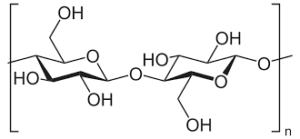Q. Each year a large amount of plant material, cellulose, is deposited on the surface of Planet Earth. What are the natural processes this cellulose undergoes before yielding carbon dioxide, water and other end products ?
Ans: The natural processes through which cellulose undergoes transformation into carbon dioxide, water, and other end products are primarily carried out by decomposers in ecosystems. Decomposers are microorganisms like bacteria, fungi, and detritivores (such as insects and earthworms) that break down organic matter into simpler substances.

Decomposition of cellulose
- Decomposition: When plant material, including cellulose-rich components like leaves, branches, and stems, falls to the ground, decomposers begin breaking down these materials. Fungi and bacteria are key decomposers in this process. They secrete enzymes that break down complex organic compounds like cellulose into simpler molecules.
- Fragmentation: Decomposers physically break down the larger plant material into smaller fragments, increasing the surface area available for microbial action.
- Microbial Decomposition: Enzymes secreted by fungi and bacteria hydrolyze cellulose molecules into smaller sugar units like glucose. This process involves the breakdown of cellulose’s complex molecular structure into simpler compounds.
- Fermentation and Respiration: Microorganisms use these sugar molecules as a source of energy through processes like fermentation and respiration. Fermentation produces organic acids, alcohols, and gases as byproducts, while respiration releases carbon dioxide and water.
- Mineralization: As decomposition progresses, the organic molecules are further broken down into inorganic compounds. The process of mineralization releases nutrients, such as nitrogen, phosphorus, and potassium, back into the soil, making them available for plant uptake.
- Carbon Dioxide and Water Release: During the respiration process, microorganisms consume oxygen and release carbon dioxide and water into the environment. This carbon dioxide contributes to the carbon cycle, and water is either retained in the soil or returned to the atmosphere through evaporation.
- Nutrient Cycling: The released nutrients, inorganic compounds, and transformed organic matter become available to plants and contribute to nutrient cycling within ecosystems.
- Humus Formation: Some of the transformed organic matter forms stable, dark-colored organic material called humus. Humus enhances soil fertility, structure, and water-holding capacity.
- Food Web Dynamics: Detritivores, such as earthworms, insects, and other small organisms, further break down the partially decomposed plant material, feeding on the microbes and organic matter. This contributes to nutrient recycling and the transfer of energy through the food web.
- Completion of Decomposition: Over time, the cellulose and other plant materials are broken down into simpler molecules, and the end products include carbon dioxide, water, minerals, and stabilized organic matter.
These natural processes of decomposition and nutrient cycling are crucial for maintaining the health and productivity of ecosystems. They play a significant role in recycling nutrients, regulating carbon dioxide levels in the atmosphere, enriching soil fertility, and supporting the growth of new plants.
Thanks for reading answer to the question: Each year a large amount of plant material, cellulose, is deposited on the surface of Planet Earth. What are the natural processes this cellulose undergoes before yielding carbon dioxide, water and other end products ?
Read: